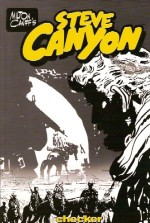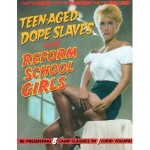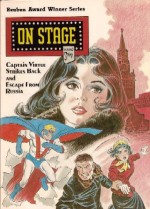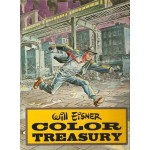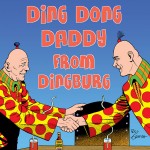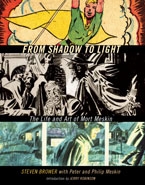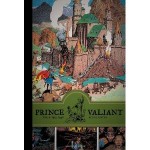
By Hal Foster (Fantagraphics Books)
ISBN: 978-1-60699-348-4
Win’s Christmas Gift Recommendation: Perfect for everybody who ever dreamed or wondered…  9/10
Rightly reckoned one of the greatest comic strips of all time, this saga of a king-in-exile who became one of the greatest warriors in an age of unparalleled heroes is at once fantastically realistic and beautifully, perfectly abstracted – a meta-fictional paradigm of adventure where anything is possible and justice will always prevail. It is the epic we all aspire to dwell within…
Of one thing let us be perfectly clear: Hal Foster’s Prince Valiant is not historical. It is far better than that.
Possibly the most successful and evergreen fantasy creation ever conceived, Prince Valiant in the Days of King Arthur launched on Sunday 13th February 1937, a glorious weekly full-colour window not onto the past but rather onto a world that should have been. It followed the life and adventures of a refugee boy driven by invaders from his ancestral homeland in of faraway Thule who rose to become one of the mightiest heroes of the age of Camelot.
Crafted by the incredibly gifted Harold “Hal†Foster, this noble scion would over the years grow to manhood in a heady sea of wonderment, roaming the globe and siring a dynasty of equally puissant heroes whilst captivating and influencing generations of readers and thousands of creative types in all the arts. There have been films, cartoon series and all manner of toys, games and collections based the strip – one of the few to have lasted from the thunderous 1930s to the present day (over 3750 episodes and counting) and even in these declining days of the newspaper strip as a viable medium it still claims over 300 American papers as its home.
Foster produced the strip, one spectacular page a week until 1971, when, after auditioning such notables as Wally Wood and Gray Morrow, Big Ben Bolt artist John Cullen Murphy was selected to draw the feature. Foster carried on as writer and designer until 1980, after which he fully retired and Murphy’s son assumed the scripter’s role.
In 2004 Cullen Murphy also retired (he died a month later on July 2nd) and the strip has soldiered on under the extremely talented auspices of artist Gary Gianni and writer Mark Schultz – who wrote the fascinating forward ‘Yes, He Was a Cartoonist’ which opens this second stupendous chronological collection.
This exquisite hardback volume, reprints in glorious colour – spectacularly restored from Foster’s original Printer’s Proofs – the perfectly restored Sunday pages from January 1st 1939 to 29th December 1940, following the extremely capable squire of Sir Gawain as he rushes to warn Camelot of an impending invasion by rapacious Saxons via the vast Anglian Fens where the Royal Family of Thule have hidden since being ousted from their Nordic Island Kingdom by the villainous usurper Sligon.
After a breathtaking battle which sees the Saxons repulsed and the battle-loving boy-warrior knighted upon the field of victory, Valiant begins a period of globe-trotting through the fabled lands of Europe just as the last remnants of the Roman Empire is dying in deceit and intrigue.
Firstly Val journeys to Thule and returns his father to the throne, narrowly escaping the alluring wiles of a conniving beauty with an eye to marrying the Heir Apparent, then bored with peace and plenty the roving royal wildcat encounters a time-twisting pair of mystical perils who show him the eventual fate of all mortals. Sobered but not daunted he then makes his way towards Rome, where he will become unwittingly embroiled in the manic machinations of the Last Emperor, Valentinian.
Before that however he is distracted by an epic adventure that would have struck stunning resonances for the readership at the time. With episode #118 (14th May 1939) Val joined the doomed knights of mountain fortress Andelkrag, who alone and unaided held back the assembled might of the terrifying hordes of Attila the Hun which had decimated the civilisations of Europe and now gathered to wipe out its last vestige.
With Hitler and Mussolini hogging the headlines and Modern European war seemingly inevitable Val joined the Battle of Decency and Right against untrammelled Barbarism. His epic struggle and sole survival comprise one of the greatest episodes of glorious, doom-fated chivalry in literature…
After the fall of the towers of Andelkrag, Valiant made his way onward to the diminshed Rome, picking up a wily sidekick in the form of cutpurse vagabond Slith. Once more he was distracted however, as the Huns delayed. The indomitable lad resolved to pay them back in kind, and gathered dispossessed victims of Hunnish depredations, forging them into a resistance army of guerrilla-fighters – the Hun-Hunters…
Thereafter he liberated the vassal city of Pandaris, driving back the invaders and their collaborator allies in one spectacular coup after another.
Valiant reunited with equally action-starved Round Table companions Sir Tristram and Sir Gawain to make fools of the Hun, who had lost heart after the death of their charismatic leader Attila (nothing to do with Val, just a historical fact). When Slith fell for a beauteous warrior princess, the English Knights left him to a life of joyous domesticity and moved ever on.
An unexpected encounter with a giant and his unconventional army of freaks led to the heroes inadvertently helping a band of marshland refugees from Hunnish atrocity found the nation-state of Venice before at long last after a after a side-trip to the fabulous city of Ravenna the trio crossed the fabled Rubicon and plunged into a hotbed of political tumult.
Unjustly implicated in a web of murder and double-dealing, the knights barely escaped with their lives and split up to avoid pursuit. Tristan returned to England and a star-crossed rendezvous with the comely Isolde, Gawain took ship for fun in Massilia and Valiant, after an excursion to the rim of fiery Vesuvius, boarded a pirate scow for Sicily and further adventure.
To Be Continued…
This series is a non-stop rollercoaster of action and romance, blending realistic fantasy with sardonic wit and broad humour with unbelievably stirring violence, all rendered in an incomprehensibly lovely panorama of glowing art. Beautiful, captivating and utterly awe-inspiring Prince Valiant is a World Classic of storytelling, and this magnificent deluxe is something no fan can afford to be without.
If you have never experienced the majesty and grandeur of the strip this astounding and enchanting premium collection is the best way possible to start and will be your gateway to a life-changing world of wonder and imagination…
Prince Valiant © 2009 King Features Syndicate. All other content and properties © 2009 their respective creators or holders. All rights reserved.


